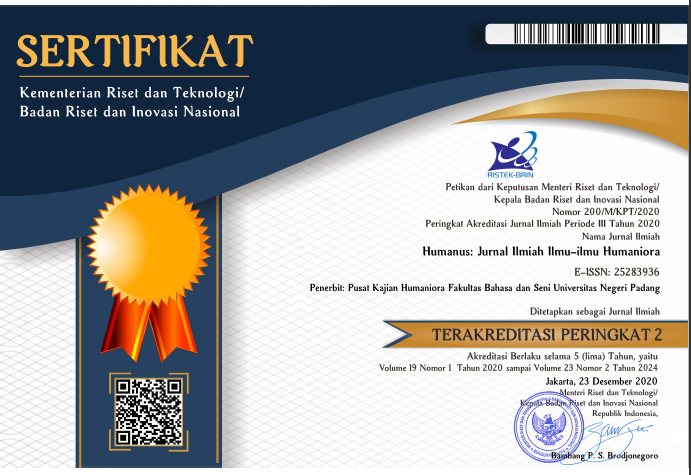Balenciaga's Statement on the Ads Campaign Controversy: Critical Discourse Analysis
 ),
), (1) Diponegoro University
(2) Diponegoro University
 Corresponding Author
Corresponding Author
Copyright (c) 2024 Annisa Kharismi
DOI : https://doi.org/10.24036/humanus.v23i2.124416
Full Text:
 Language : en
Language : en
Abstract
This study aims to explore and analyze Balenciaga brand statements that are sought to assist in responding after controversy suspected regarding Balenciaga for their choice for adoption of pornography and child exploitation principles. This study applies the qualitative descriptive approach using the theory of critical discourse analysis by Teun A. van Dijk (1993) comprising the dimension of text, social cognition and social context accompanied by Balenciaga’s defensive strategies that emerged from Hood (2011) blame theory. Data were gathered from the social media narrative of Balenciaga official Instagram account. From the results, there were four strategies that Balenciaga employed in using blame-avoiding strategy of image repair which are accepting, downplaying, shifting, and denying.
Keywords
References
Adler, H., Baker, E., Case, M. A., Coughlin, A., Dorf, M., Eisgruber, C., Filler, D., Friedman, B., Garland, D., Greene, A., Halley, J., Kahan, M., Kramer, L., Kraus, J., Magill, L., Marx, P., Miller, G., Nelkin, D., Pildes, R., … Vogel, J. (2001). The Columbia Law Review. http://journal.law.ufl.edu/techlaw/4-2/cox.html.
Davies, D. M., & Koller, V. (n.d.). “Metaphoring” people out of this world: A Critical Discourse Analysis of a chairman’s statement of a UK defence firm Metaphoring’ people out of this world: A Critical Discourse Analysis of a chairman’s statement of a UK defence firm. http://ssrn.com/abstract=1839174Electroniccopyavailableat:http://ssrn.com/abstract=1839174
Fuoli, M., & Hart, C. (2018). Trust-building strategies in corporate discourse: An experimental study. Discourse and Society, 29(5), 514–552. https://doi.org/10.1177/0957926518770264
Hansson, S. (2015). Discursive strategies of blame avoidance in government: A framework for analysis. Discourse and Society, 26(3), 297–322. https://doi.org/10.1177/0957926514564736
Hansson, S. (2018). Defensive semiotic strategies in government: a multimodal study of blame avoidance. Social Semiotics, 28(4), 472–493. https://doi.org/10.1080/10350330.2017.1334358
Herbst, K. C., Finkel, E. J., Allan, D., & Fitzsimons, G. M. (2012). On the dangers of pulling a fast one: Advertisement disclaimer speed, brand trust, and purchase intention. Journal of Consumer Research, 38(5), 909–919. https://doi.org/10.1086/660854
Hood, C. (2011). The Blame Game: Spin, Bureaucracy, and Self-Preservation in Government. Princeton University Press.
Janks, H. (n.d.). Critical Discourse Analysis as a Research Tool.
Johannesson, L., & Weinryb, N. (2021). How to blame and make a difference: perceived responsibility and policy consequences in two Swedish pro-migrant campaigns. Policy Sciences, 54(1), 41–62. https://doi.org/10.1007/s11077-020-09407-x
Liu, M. (2023). Blame-avoiding strategies for a digital scandal A critical discourse analysis of Mark Zuckerberg ’ s Congressional hearings. April. https://doi.org/10.1075/ps.21063.liu
Saedeen, M., & AlBzour, N. N. (2022). Donald Trump’s Denial Speeches of the 2020 United States Presidential Election’s Results: A Critical Discourse Analysis Perspective. Advances in Language and Literary Studies, 13(1), 32. https://doi.org/10.7575/aiac.alls.v.13n.1.p.32
Van Dijk, T. A. (1993). Principles of critical discourse analysis (Vol. 4, Issue 2).
 Article Metrics
Article Metrics
 Abstract Views : 240 times
Abstract Views : 240 times
 PDF Downloaded : 117 times
PDF Downloaded : 117 times
Refbacks
- There are currently no refbacks.
Copyright (c) 2024 Annisa Kharismi

This work is licensed under a Creative Commons Attribution-NonCommercial 4.0 International License.










